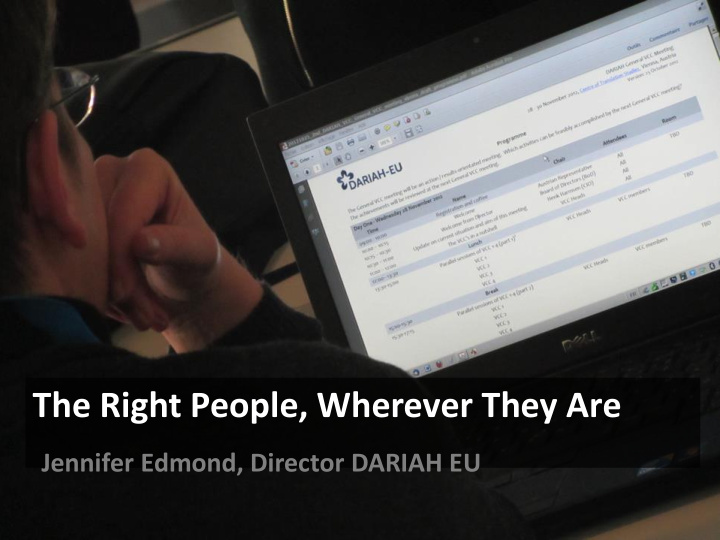



The Right People, Wherever They Are Jennifer Edmond, Director DARIAH EU
The humanistic research instrument is a human one. People are therefore central to our strategy. But it is the mobility of knowledge, not bodies, that is most critical
The Four Pillars of DARIAH ’ s Strategy Marketplace for quality assured Transnational Scientific Working Tools, Services and Data Groups on Emergent Themes Training and Professional Policy and Foresight Work to Development for all Career Stages Optimise the Environment
How is DARIAH Different? • Arts and Humanities is a VERY diverse space – Technology unifies us • Strong and diverse (but aligned) national nodes – Number of members: 17 now, 12 in active development • Cash versus In-Kind Contributions (10%/90%) • Not a direct employer (yet); indeed barely an employer at all, more an infrastructure of ‘ prosumers ’ or ‘ produsers ’
How Big is DARIAH (2017)? 1003 DARIAH Wiki Users 100,000+ Stakeholders 12 Total In Research, Core potential Policy and 182 Staff user base Cultural National of 5 mill.? Heritage Institutions 162 Annual Meeting Attendees
Staff and People in DARIAH • Specialised versus generic staff (60/40 split) – Finance, operations, funding – Para-academic roles, community- or policy-facing, data challenges specific to communities • Professional mobility generally very proximate (same institution, projects, related RIs) • Operationally similar to the concept of the #Alternate Academy (attractions thereof) • ‘ Hygiene factors ’ versus ‘ real ’ HR investment
Capacity Building Measures • Need for stronger links to academia – PARTHENOS Task on integration with HE, – development of shared internship programmes • Physical mobility (esp. TNA) a key instrument – Humanists learn digital methods in context, from peers (Antonjevic, 2015) • Need for promotion of specific skills – Specific Training Schools (eg. Digital Lexicography) – PARTHENOS Task on Training
The PARTHENOS Training Suite: Exposing RI Knowledge for Humanities
http://training.parthenos-project.eu/training-modules/
http://training.parthenos-project.eu/training-modules/ 1 0
http://training.parthenos-project.eu/training-modules/ • Introduction to Research Data Management – FAIR Principles – Data Seal of Approval – Cultural Heritage Assets • Data Management Planning • Ethics and Research • Data Quality Assessment • Open Data, Open Access, Open Science • Research Infrastructures and Data Policy
Research Infrastructure is NEVER done • We new models to engage and service these ‘ prosumers/produsers, ’ including visibility • We also need to be able to harness existing mechanisms better: – to also allow eg. management staff to do research degrees (service mission not a fixed point) – To use TNA more flexibly (for mentoring, for example, or for group capacity building, as blended) – To reach into communities where transformation is still in process and build in concert with them
Thank you
Recommend
More recommend